ISSN ONLINE(2319-8753)PRINT(2347-6710)
ISSN ONLINE(2319-8753)PRINT(2347-6710)
R.Meghalai 1, K.saraladevi 2
|
| Related article at Pubmed, Scholar Google |
Visit for more related articles at International Journal of Innovative Research in Science, Engineering and Technology
The study aims to determine the factors involved in identifying mathematics high achievers emotions. Stratified random sampling technique was used for the selection of the sample. From the total population of 750, 38 school students were selected from three different schools in Chennai city. Personal data sheet developed by the investigator.„Students Negative Emotions‟ was measured using Revised Children Manifest Anxiety Scale prepared by Reynolds&Richmond,(1985)and Depression scale (Self analysis questionnaire) prepared by C.D.Speilberger,( 1990). „Students Positive Emotions‟ was measured using Subjective Happiness Scale prepared by Sonja Yubomirsky,(1999)and Scales of Psychological well-Being prepared by Carol Ryff,( 1989), were used to collect data. Results were statistically analyzed through „t‟ test, correlation coefficient. In this present research depression, subjective happiness, psychological well being and gender are identified as the determing factors of manifest anxiety among mathematics high achievers.
Keywords |
| Anxiety, Depression, Subjective happiness, Psychological well-being and Mathematics high achievers. |
INTRODUCTION |
| Taking the whole positive emotions into consideration, working on learning more viewpoints, interacting more with others and enjoying makes things better. Positive emotions are fuelled by an underlying desire for enjoyment and unity. Negative emotions express an attempt or intention to exclude strengthening one's own position at the expense of others. Keeping bad stuff away, destroying what is perceived as a threat. Negative emotions are fuelled by an underlying fear of the unknown, a fear of the actions of others and a need to control them or stop them to avoid being harmed. |
RELATED WORK |
| Conceptual and empirical literature review has been carried out in Mathematics High Achievers. Fundamental in mathematics are mathematical facts, skills, concepts, principles, theorem proving and problem solving. The gains embedded in these fundamentals are very significant in terms of transferability of principles and strategies, analytical powers, the application of analysis to diverse situations, the presentation of arguments and evidence to convince someone to accept the proof. All these processes require the operation of higher order thinking domains like analysis, synthesis, evaluation, deductive and inductive reasoning, convergent and divergent thinking. If these processes are so significant, students cannot afford to enter secondary schools with a history of failure in mathematics. Least of all the argument that mathematics is for a few cannot be used to explain mathematics disabilities. Furthermore, other factors such as gender, age, family circumstances and the extent or intensity of the concern may contribute to how studentâÃâ¬ÃŸs emotions are employed. Gender is defined by FAO as „the relations between men and women both perceptual and material. Gender is not determined biologically, as a result of sexual characteristics of either women or men, but is constructed socially. It is a central organizing principle of societies and often governs the processes of production and reproduction, consumption and distribution (FAO, 1997). Gender roles are the „social definitionâÃâ¬ÃŸ of women and men. They vary among different societies and cultures, classes, ages and during different periods in history. Gender-specific roles and responsibilities are often conditioned by household structure, access to resources, specific impacts of the global economy, and other locally relevant factors such as ecological conditions (FAO, 1997). Despite this definition, gender is often misunderstood as being the promotion of women only. However, as we see from the FAO definition, gender issues focus on women and on the relationship between men and women, their roles, access to and control over resources, division of labour, interests and needs. Gender relations affect household security, family well-being, planning, production and many other aspects of life (Bravo-Baumann, 2000). In the light of this context the present study is entitled as students emotions among Mathematics high achievers” for the present research has been taken up. The focus for this study is on high school and higher secondary school students. A stratified random Sampling technique that was used for the selection of the sample in this case was random sampling technique. A total of 38 school students were selected from three different schools in Chennai city. The investigator selected 13 students from Government from Government aided school and 14 students from private school. |
SAMPLE |
| The investigator selected 13 students from government school, 11 students from Government Aided School and 14 students from Private school. |
OBJECTIVES OF THE STUDY |
| To find out the level of students emotions among mathematics high achievers to know the gender impact on children manifest anxiety, Psychological well-being, Depression and Subjective happiness. |
HYPOTHESES OF THE STUDY |
| Gender has no impact on children manifest anxiety, Psychological wellbeing, Depression and Subjective happiness. |
RESEARCH TOOLS SELECTED FOR THE PRESENT STUDY |
| The following tools have been used by the investigator to carry out this study. |
| 1) Personal data sheet developed by the investigator. |
| 2) Students Negative Emotions was measured using Revised Children Manifest Anxiety Scale prepared by Reynolds & Richmond, (1985) and Depression scale (Self analysis questionnaire) prepared by C.D.Speilberger, (1990). |
| 3) Students Positive Emotions was measured using Subjective Happiness Scale prepared by Sonja Lyubomirsky, (1999) and Scales of Psychological well-Being prepared by Carol Ryff, (1989). |
| Table 1: Differentiation of children manifest anxiety between boys and girls. |
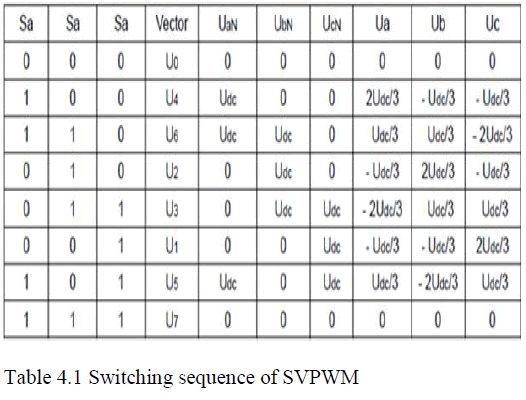 |
| Table 1 showing the differentiation of Children manifest anxiety between boys and girls. |
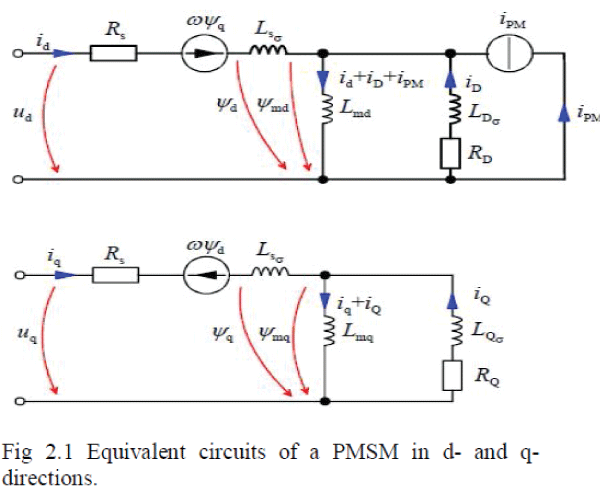 |
| Table 2: Differentiation of Psychological well being between boys and girls. |
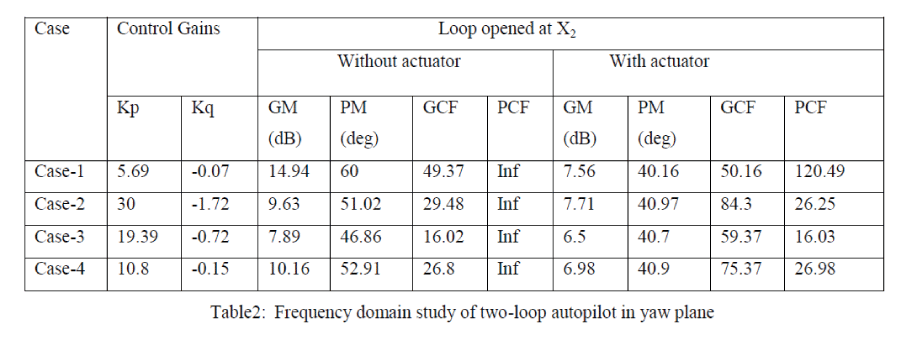 |
| Table 2 showing the Differentiation of Psychological well being between boys and girls. |
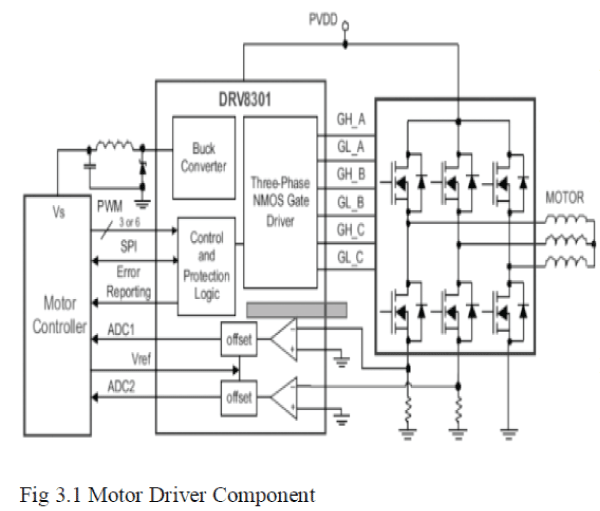 |
| 1- Boys 2- Girls |
| Table 3: Differentiation of Depression between boys and girls. |
 |
| Table 3 showing the differentiation of Depression between boys and girls. |
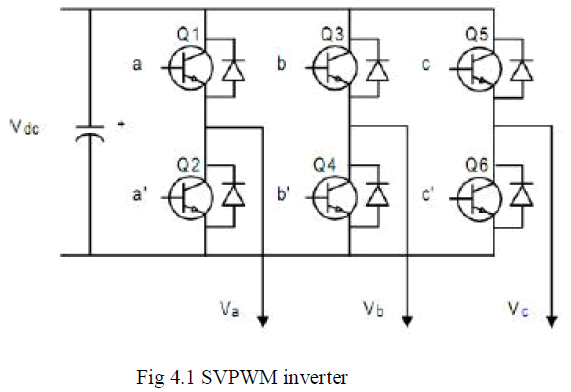 |
| 1- Boys 2- Girls |
| Table 4: Differentiation of Subjective happiness between boys and girls. |
 |
| Table 4 showing the differentiation of subjective happiness between boys and girls. |
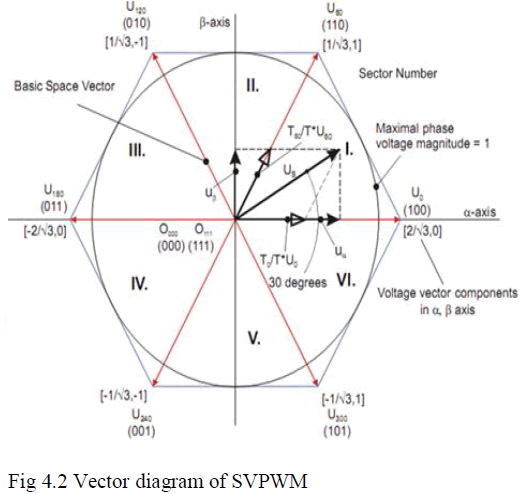 |
| Table 5: Relationships between Children Manifest Anxiety and Psychological well being. |
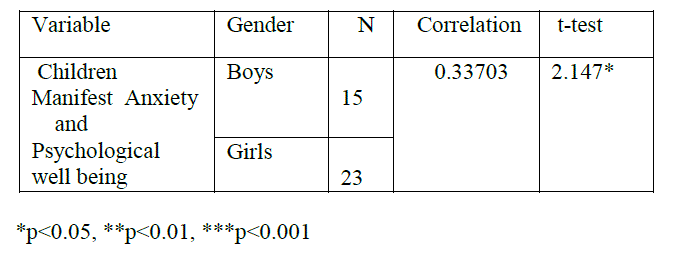 |
| Table 6: Relationships between Children Manifest Anxiety and Depression. |
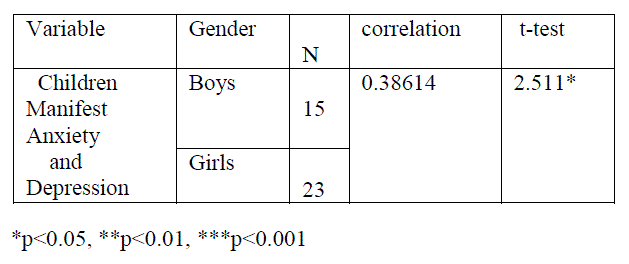 |
| Table 7: Relationships between Children Manifest Anxiety and Subjective happiness. |
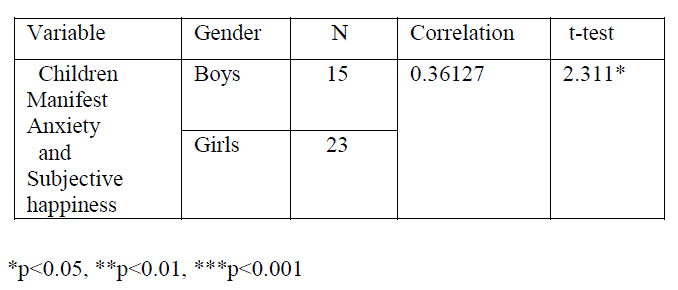 |
| Table 8: Relationships between Psychological well being and Depression. |
 |
| Table 9: Relationships between Psychological well being and Subjective happiness. |
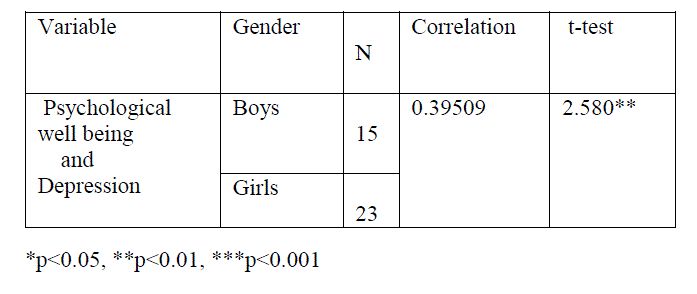 |
| Table 10: Relationships between Depression and Subjective happiness. |
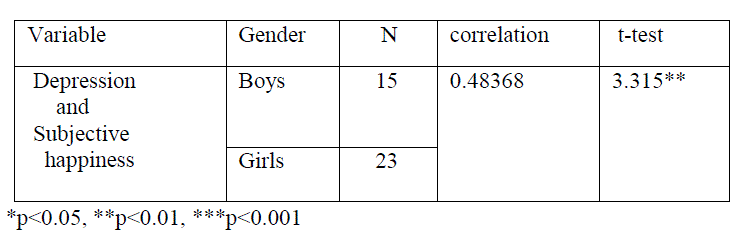 |
| From the table 1, it is observed that the obtained t-value (p<0.01) is greater than the table value (2.58) at 0.01 level of significance. Hence it is inferred that there is significant difference in children manifest anxiety between boys and girls. Hence the hypothesis is rejected. |
| From the above table 2, it is observed that the obtained t-value (p<0.001) is greater than the table value (2.58) at 0.01 level of significance. Hence it is inferred that there is significant difference in children manifest anxiety of boys between girls. Hence the hypothesis is rejected. |
| From the above table 3, it is observed that the obtained t-value (p<0.001) is greater than the table value (2.58) at 0.01 level of significance. Hence it is inferred that there is significant difference in Depression between boys and girls. Hence the hypothesis is rejected |
| From the above table 4, it is observed that the obtained t-value (p<0.05) is greater than the table value (1.96) at 0.05 level of significance. Hence it is inferred that there is significant difference in Subjective happiness between boys and girls. Hence the hypothesis is rejected. |
| From the above table 5, it is observed that the obtained t-value (p<0.05) is greater than the table value (1.96) at 0.05 level of significance. Hence it is inferred that there is relationships between Children Manifest Anxiety and Psychological well being. Hence the hypothesis is rejected. |
| From the above table 6, it is observed that the obtained t-value (p<0.05) is greater than the table value (1.96) at 0.05 level of significance. Hence it is inferred that there is relationships between Children Manifest Anxiety and Depression. Hence the hypothesis is rejected. |
| From the above table 7, it is observed that the obtained t-value (p<0.01) is greater than the table value (1.98) at 0.05 level of significance. Hence it is inferred that there is relationships between Children Manifest Anxiety and Subjective happiness. Hence the hypothesis is rejected. |
| From the above table 8, it is observed that the obtained t-value (p<0.01) is greater than the table value (2.58) at 0.01 level of significance. Hence it is inferred that there is relationships between Psychological well being and Depression. Hence the hypothesis is rejected. |
| From the above table 10, it is observed that the obtained t-value (p<0.01) is greater than the table value (2.58) at 0.01 level of significance. Hence it is inferred that there is relationships between Depression and Subjective happiness. Hence the hypothesis is rejected. |
| The present study is supported by the following research studies. The psychometric properties of the Revised children Manifest anxiety scale-second edition ( RCMAS-2) were examined in a sample of 1,003 U.S elementary and secondary students in grades 2 to 12.latent mean analyses were also conducted and the results of these analyses indicated that females scored significantly higher than males on the three anxiety factors. (Lowe et al., 2014). In a cross sectional study all students of both sexes studying in class VIII, were assessed using the Spence anxiety scale. The sample consisted of 146 (55% male and 45% female) with a mean age of 12.71 years. A total of 16 (11%) students scored above cut off for high anxiety, the mean scores across gender shows that female students scored significantly higher in total and all sub types of anxiety. The prevalence of high anxiety was 11% in class VIII students. High anxiety in students was significantly associated with female gender and authoritarian parenting pattern as perceived by the children.( bakhla,et al., 2013). Asha P.Vataliya studied psychology Well –being in Adolescence of gender Difference. The total sample consisted 60 Adolescent. 30 of Girls and 30 Boys of 11th standard students selected from the Bhavnagar city, the research tool for psychological well- being scale developed by svdha boggle (1995). In this research girls and boys were very far differentiated in psychological well-being.( Vataliya, 2014). Neerpal Rathi and Renu Rastogi (2007) examined meaning in life and psychological well-being in male and female students of pre- adolescence and adolescence periods. A total of 104 students were randomly selected from various schools. Of these, 54 students were from class 12 and 50 students from class 9. In that research there were significant differences in the perception of life as meaningful and psychological well-being of different groups of students; t-test was applied to analyze the data.Epidemiological findings point to a female preponderance in prevalence incidence and morbidity risk of depressive disorders. |
| Moreover, age is a crucial factor, and higher rates of depression in females are detected at mid-puberty through adult life, as opposed to a male preponderance until early adolescence. The female preponderance is not ubiquitous and is limited, or even absent, in traditional societies and in socially homogeneous samples). This paper aims to review putative risk factors leading to gender differences in depressive disorders.(Piccinelli & Wilkinson, 2000).Nolen- Hoeksema, Larson, and Grayson (1999) examined how social conditions and personality characteristics affect each other and contribute to the gender difference in depressive symptoms. In their study, women reported more chronic strain, a greater tendency to ruminate, and a lower sense of mastery than men. But other researchers, such as Cochran and Rabinowitz (2000) and Pollack (1998), believe that men and women may experience comparable levels of depression but express it in different ways. Pollack notes that when the percentages of alcohol abuse, depression, and antisocial personality disorder in men and the percentages for depression and anxiety disorders for women are combined, the results are comparable.(Nolen-Hoeksema et al., 1999). This study focuses on emotion based coping and subjective happiness among the higher secondary students. A total of 300 students were selected from three different schools in Chennai city. The investigator selected 100 students from Government school, 100 students from Government Aided School and 100 students from Private school. Gender has an impact on emotion based coping and subjective happiness, emotion based coping and subjective happiness are related to each other. (Joseashwinanand et al., 2013).Global and school-related happiness were measured in 339 Finnish ninth graders, about 86% of whom had participated in a study on the happiness of sixth graders three years earlier. The factor most desired to increase happiness was more success at school followed by the desire for more money, more free time and a girlfriend or boyfriend. Girls with a high grade-point average were happier than other girls, globally and at school. Among boys, no such differences appeared.( Lotta Uusitalo-Malmivaara, 2014).Furthermore, just as coping strategies varied by gender in predicting psychological outcomes. Mindfulness, self-compassion, and self-efficacy vary by gender in predicting depression, anxiety, stress, and well-being in undergraduates.( Ólafsson & Jóhannsdóttir, 2004; Woodhead et al., 2013).This study prospectively examines gender differences in the relationship between anxiety and depressive symptoms in early adolescence. One hundred thirteen 11 to 14 year old middle school students assessing depressive symptoms and anxiety. Total anxiety and worry and oversensitivity symptoms are found to predict later depressive symptoms more strongly for girls than for boys. Physiological anxiety predicts later depressive symptoms for both boys and girls. These findings highlight the importance of anxiety for the development of depression in adolescence among girls. ( Chaplin et al., 2009). The aim of this cross-sectional, descriptive study was to assess the subjective well-being status of a group of primary healthcare patients in relation to socio-demographic characteristics, personal health and mood-status. A total of 284 patients participated in the study. In general, the participants were found to be moderately happy and satisfied with their lives. They had mild levels of depression, anxiety and stress. In terms of happiness, an older age (≥40 years), educated to secondary level or higher and not having depression or anxiety were found to be factors increasing happiness. In terms of life satisfaction, female gender, an older age (≥40 years), and educated to secondary level or higher, being single and not having depression were found to increase life satisfaction. (Ozcakir et al., 2014). The study of mental health effects of added burden related to socially disadvantaged status (being African- American or Latino, female, young, and identifying as bisexual versus gay or lesbian) in a community sample of 396 self-identified lesbian, gay and bisexual (LGB) adults. Mental health outcomes were social and psychological wellbeing contrasted with depressive symptoms. We found different patterns when looking at social vs. psychological wellbeing and positive vs. negative mental health outcomes. Though no differences in social or psychological well-being were found by gender, female gender was associated with depressed mood.( Robert M. Kertzner et al., 2010). This study examines the demographic correlates of psychological well-being and mental health among older African American women. Results indicate that psychological well-being and mental health are associated with specific demographic factors. In addition, self-rated health and limited mobility due to disability exerted significant influences on psychological well-being, depressive symptoms, and psychological distress. Findings were discussed in associations with well-being and mental status among older African American women. (Nguyen, 2013).The present study investigated the role of self-construal in explaining psychological wellbeing in two European countries. Eight hundred and fifteen Italian and Scottish students completed measures of life-satisfaction, optimism, subjective happiness and a scale ensuring interdependent and independent self-construal. We obtained three main findings. First of all, scores on the scales of psychological wellbeing were positively associated with scores on the independent scale and independence was found to be the factor that best explained variance in psychological wellbeing. Second, and contrary to our prediction, the Italian group had significantly higher scores for the independence scale than Scots. Third, gender was found to have a significant effect with regard to interdependence of self, life satisfaction, and optimism.( Duncan, 2012). The present study explores the subjective well-being of Malaysian children between 12 and 14 years of age. They are confronted by a range of social and developmental influences that impact of their self concept, self esteem, independence skills and their sense of their personal well-being. Significant differences between the male and female participants were noted with males rating their subjective well-being as higher than the ratings by females on their “satisfaction with life as a whole” as well as their happiness. (Clark, 2014). In this study happiness and depression in 737, 12 year old Finnish children were predicted by relationships with family members and other people. There were no differences in happiness between the genders, but the girls were more depressed than the boys. Depression was accounted for by poor family relationships of number of close friends and parental fighting in the girls. In the boys, depression was related to poor family relationships and the number of close friends. Thus, the factors explaining happiness and depression were partly different and not necessarily interrelated.( Uusitalo-Malmivaara et al., 2012).The aim of this study was to investigate gender differences in the associations between symptoms and subjective wellbeing, self-esteem, school functioning and social relations in adolescents. Data were taken from a major populationbased Norwegian study, the Nord-Trondelag Health study (HUNT) in which 8984 (91% of all invited) adolescents aged 13–19 years completed. Although prevalence rates of symptoms of anxiety and depression were higher in girls than in boys, a significant interaction between gender and symptoms of anxiety and depression were found. These interactions indicate that the associations between symptoms of anxiety and depression and lower subjective well-being and selfesteem, more academic problems in school and lower social functioning were stronger for boys than for girls. The findings were contribute to an earlier assessment and more efficient treatment of male adolescent anxiety and depression.( Ruth Derdikman-Eiron et al., 2011). |
DISCUSSION |
| The present study reveals that females are more anxious than males as concluded by Lowe et al., 2014 and bakhla et al., 2013 because women have always been capable of scoring higher and also of discriminatory gender socializing and never realized their own potential. Also, girls have more psychological well being than boys as concluded by vataliya 2014 and Rathi & Rastogi 2014 because adolescents classified as highly securely attached reported greater satisfaction with themselves and a higher likelihood of seeking social support which are more likely to be in girls compared to boys.It is also revealed that males are more depressed compare to females as concluded by Nolen-Hoeksema et al., 1999 because Depression in men may cause them to keep their feelings hidden. Instead of expressing a depressed mood, they may seem more irritable and aggressive than women. Also, that boys have more subjective happiness than girls as concluded by Joseashwinanand & saraladevi, 2013 because, it is presented by Ingram, Cruet, Johnson, and Wisnicki (1988), is related to the greater amount of attention women give to their inner emotional state. Therefore, it seems that women more easily communicate and recognize such feelings and manifestations (Ingram et al., 1988).It is also revealed that there is relationship between children manifest anxiety and psychological well being as concluded by Derdikman-Eiron, 2011 These interactions indicate that the associations between symptoms of anxiety and depression and lower subjective well-being and self-esteem, more academic problems in school and lower social functioning were stronger for boys than for girls. It is also observed that there is relationship between psychological well being and Depression as concluded by Kertzner et al., 2010 because though no differences in social or psychological well-being were found by gender, female gender was associated with depressive mood. Also, there is relationship between psychological well being and subjective happiness as concluded by Duncan, 2012 and clark, 2014 because Significant differences between the male and female participants were noted with males rating their subjective well-being as higher than the ratings by females on their “satisfaction with life as a whole” as well as their happiness. It is also observed that there is relationship between Depression and subjective happiness because there was no difference between the gender, but the girls are more depressed than the boys. Depression was accounted for by poor family relationship in both boys and girls. Anxiety and depression occur in both genders, but by the teenage years, girls are much more at risk than boys. Before puberty, the prevalence of mood disorders is about the same in boys and girls of 3 to 5 percent. But by mid-adolescence girls are more than twice as likely to be diagnosed with a mood disorder as boys, with the prevalence at adult levels, 14 to 20 percent. We know from looking at brain scans that there are differences in the way girls and boys process emotional stimuli. Girls mature, in terms of their emotional recognition, faster than boys and that sensitivity could make them more vulnerable to depression and anxiety. |
EDUCATIONAL IMPLICATIONS |
| Although the educational applications of emotion research are still quite tentative, several general themes are emerging and they tend to support a perspective that many educators have long advocated. This isn't surprising, since we're continually learning what does and doesn't work when dealing with students' emotions. What this research may provide, however, is biological support for the profession's beliefs. |
| Here are some general principles and their applications to the classroom: |
| 1. Emotions simply exist, we don't learn them in the same way we learn telephone numbers, and we can't easily change them. But we should not ignore them. Students can learn how and when to use rational processes to override their emotions, or to hold them in check. We should seek to develop forms of self-control among students and staff that encourage on judgmental, non disruptive venting of emotion that generally must occur before reason can take over. |
| 2. Most students already know quite a bit about the complexity of emotions and the ways they and others experience them (Saarni and Harris 1991), although they may not be able to articulate what they know. Schools should focus more on Meta cognitive activities that encourage students to talk about their emotions, listen to their classmateâÃâ¬ÃŸs feelings, and think about the motivations of people who enter their curricular world. Activities that emphasize social interaction and that engage the entire body tend to provide the most emotional support. Games, discussions, field trips, interactive projects, cooperative learning, physical education, and the arts are examples. Although we've long known that such activities enhance student learning, we tend to think of them as special rewards, and so withdraw them when students misbehave, or when budgets are tight, eliminate them altogether. |
| 3. Memories are contextual. School activities that draw out emotions simulations, role playing and cooperative projects, for example may provide important contextual memory prompts that will help students recall the information during closely related events in the real world. Emotionally stressful school environments are counterproductive because they can reduce students' ability to learn. Self-esteem and a sense of control over one's environment are important in managing stress. Highly evaluative and authoritarian schools may promote institutional economy, efficiency, and accountability. But, so heighten non-productive stress in students and staff. |
DELIMITATIONS |
| 1) The sample is restricted to Mathematics high achievers. |
| 2) The sample size is restricted to 38 students only. |
CONCLUSION |
| Gender has impact on studentâÃâ¬ÃŸs emotions among mathematics high achievers. Children manifest anxiety, Depression, Psychological well being and Subjective happiness are related to each other. |